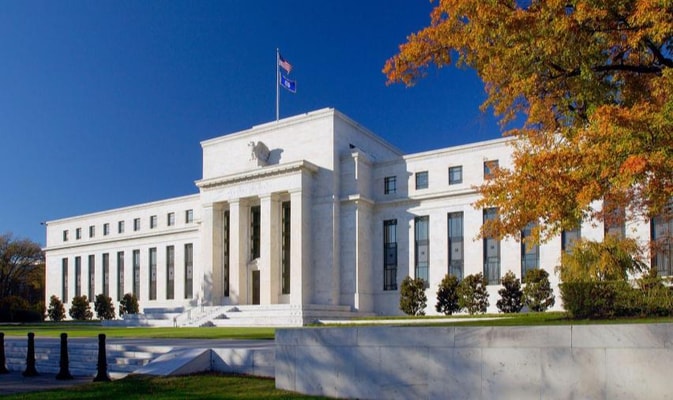Fed raises interest rates by 25 points: these are the reactions of experts

23 MAR, 2023
By Constanza Ramos

As expected by analysts, the Federal Reserve raised the rate by 25 points last night, bringing it to a target range between 4.75% and 5.00%. Although markets were expecting this hike, some were betting that the Fed would not make it due to recent developments in the banking sector with Silicon Valley Bank and Credit Suisse.
Fed Chairman, Jerome Powell indicated that the FOMC had considered holding off on raising rates due to uncertainty in the banking sector, but economic data on annual US inflation was stronger. Here are the market reactions to this new rise.
Luke Bartholomew, Senior Economist, abrdn

By raising interest rates, the Fed is trying to demonstrate its strong commitment to price stability and that it has the tools to address financial stability concerns without jeopardizing its inflation mandate. It is a very difficult path, and it is clear that the market believes that before long it will have to ease policy in response to future economic and financial market stresses.
We believe that the Fed will maintain its policy of rate hikes in the coming months, but as economic tensions increase, it will find it increasingly difficult to maintain the monetary policy and financial stability, which are two entirely separate policy areas.
Peter De Coensel, CEO at DPAM

At present, the US terminal policy rate should be reached in the second quarter of 2023 and be between 5% and 5.50%. The US Fed funds 1 year, March 2024, at 4.75%, i.e. between 2 and 3 rate cuts. US official interest rate estimates for March 2025 stand at 3.48%, i.e. another 5 rate cuts of 25 basis points. Let us remember that, at the beginning of 2022, we never thought of rate hikes of 50 bp, let alone 75 bp. We have had them all in the last 12 months. In that sense, an accommodative cycle can also be erratic.
Given the range of risk factors that exist (from geopolitics - a global poly-crisis situation - to structural indebtedness), an ocean of debt combined with interest rates that are too high for their purpose can have an unpredictable and variable impact.
Recently, we have witnessed the failure of several US banks. One of the elements that led to their demise was the sharp rise in Treasury rates. However, concentration risk, poor asset management practices, and the ability of depositors to transfer deposits at the click of a button were the main culprits in these massive withdrawals of bank deposits.
The financial system as we know it today has reached capacity limits. Central banks are aware of this. In addition to their traditional mandate of inflation and maximum employment, they also have the task of preserving financial stability. The decisions taken are the right ones. These are not bailouts. The capital and bonds of the institutions concerned will be wiped out. The currency mismatches will be long and variable. Proper risk management and diversification are the tools that will protect both companies and investors.
DWS

Fed and Treasury won’t come to the rescue. While the Fed’s 25 basis points (bps) rate hike came in as expected by most, we believe it was a toxic mix of other ingredients that unnerved markets yesterday: 1. Treasury Secretary Janet Yellen’s refusal to provide “blanket” deposit insurance to U.S. banks. 2. Fed chair Jerome Powell’s refusal to pre-commit to any measures that would help ease the pain for regional banks, stressing the need to prioritize inflation-fighting. 3. The realization that any Fed rate cut may be a long way off, while economic cooling might come faster and more violent than hoped for. That’s at least what U.S. markets said by the end of trading: the S&P 500 down by 1.65% and 10y U.S. Treasury yields down 18bps.
We stick to our 12-month forecasts as we know (and knew when we made these forecasts) from history that stark rate-hiking cycles could lead. However, there might be some downside risk to our U.S. 2023 gross-domestic-product (GDP) growth forecast of 0.7% given the structural problems facing U.S. regional banks and given their importance in providing financing to local business, real estate and households alike.
While U.S. markets didn’t really like what they heard yesterday, they are not in panic mode. Most equities are still up for the year to date and equity volatility (Vix) has come down over the past two days. But while the has only lost 1.4% so far this month, there was a lot more going on below the surface. Financials are down 12% for the month, followed by real estate equities (-9%), while tech is up 6% on average. With financials now only accounting for 10% of the market cap of the S&P 500, compared to 20% twenty years ago, tech stocks were able to save the month. In Europe, real estate is the loss leader of the month (-14%) followed by banks (-13%), while tech is only up 1%. Gold is off its month’s high, but only slightly, while Brent oil, trading at 76$/b (down 8$/b for the month), also doesn’t show much confidence in GDP growth.
We stick to the general economic picture of GDP growth slowing in Europe and reversing in the U.S. before starting a mild recovery sometime in the second half of the year. We also stick to our constructive view on most asset classes on a strategic 12-month’s view. We are aware of the threats to our core scenario as it is still not foreseeable what kind of negative dynamic the U.S. banking sector might still develop – and what other risks are looming on the horizon (Ukraine, Taiwan).
Anna Stupnytska, Global Macroeconomist at Fidelity International

The Fed raised rates by 25 basis points at its 22 March meeting, which must have been exceptionally challenging in light of the banking turmoil. The decision to go ahead with the hike is a sign of the Fed's confidence in its ability to contain financial instability while focusing on controlling inflation.
The Fed is following the ECB model, raising rates but taking a more cautious approach at each meeting. It could have paused, using the current stress in the banking system as a valid reason to take some time. But that could call into question its commitment to controlling inflation and damage its credibility, a risk that FOMC participants decided not to take at this point. Instead, the main risk for the Fed now is that this hike will backfire, further exacerbating concerns about financial instability and fuelling market turbulence.
As the crisis in the banking system continues to unfold, we believe that the likelihood of a hard landing scenario - our baseline scenario for some time now - has increased dramatically in recent days. The current market stress, a symptom of the magnitude and speed of monetary policy tightening to date, is spilling over into the real economy via the bank credit channel. The Fed's reaction function remains the key determinant of the way forward. Any sign of easing inflationary pressures and cooling labour market tightness in the coming weeks would be its lifeline, allowing it to execute the long-awaited "pivot" and signal the end of the cycle. If inflation remains elevated, the Fed is likely to try to continue with the policy of separating tools to juggle price stability and financial stability, trying to convince markets that there is no trade-off between the two. But given the role that markets and sentiment play in policy transmission, this trade-off is alive and kicking and, if it becomes even more acute, markets will test the Fed until it blinks… and finally exercises the "Fed put".
We continue to maintain a cautious stance, expressed through an underweight in credit and an overweight in cash. The end of the Fed's tightening cycle is approaching and we are aware that this could lead to a rally in risk assets in the short term. However, we believe that the significant tightening already in place, slowing growth, high inflation and now tensions in the banking sector justify a defensive approach. Overall, we continue to favour emerging markets over developed markets, although the tightening of lending standards in the US and Europe is a drag on emerging market currencies. The China re-opening story remains intact, meaning China could be a useful diversifier if developed market growth stalls or banking strains intensify.
Pablo Duarte, senior analyst at the Flossbach von Storch Research Institute

The Fed raised its benchmark interest rate by 25 basis points. The Fed really had no choice. After the financial turmoil around Silicon Valley Bank (SVB) and Credit Suisse subsided, and Janet Yellen paved the way by promising to help regional banks in the event of a sudden withdrawal of their deposits, the 25 basis points were entrenched in expectations. Had the hike been higher than 25 basis points, the Fed would have surprised markets to the upside causing a drop in valuations and additional financial stress. Had it not raised rates, it would have sent a panic signal to markets that the financial system would be more fragile than expected. It would also have undermined the credibility that it has worked so hard to regain.
In the coming weeks, the focus will be on financial conditions, which have already tightened significantly and could mean a further drag on the real economy. Moreover, it is to be expected that investments that were only profitable in a tide of cheap money will continue to float. How great the collateral damage will remain to be seen. The turmoil in the banking sector shows that the much-talked-about soft landing, i.e. curbing inflation without triggering a recession, is becoming increasingly difficult to achieve.
Paolo Zanghieri, Senior Economist at Generali Investments

Powell confirmed that, just before the collapse of the SVB, the FOMC favored raising the terminal rate based on the very strong labor market data and the unwelcome strength of inflation in the first readings for 2023. In the early days of the crisis, FOMC members considered a pause in rate hikes, but the generally good response of the banking sector to the measures put in place convinced them to broadly maintain the path outlined in December. In the meantime, quantitative tightening continues in a "predictable and passive" manner, and the FOMC sees no need to modify the process. The recent balance sheet expansion in response to the banking crisis is only intended to provide temporary liquidity relief and will not affect long-term rates (the main objective of quantitative easing and tightening).
The FOMC's current reading of the crisis is that of serious problems affecting a limited number of very specific lenders. The measures taken are considered effective and "demonstrate that the savings of all depositors are safe". This should not be taken as an endorsement to guarantee the deposits of all banks, but as an affirmation that the measures taken and those that may be implemented will be sufficient to maintain public confidence in the banking system, as shown by the reassuring deposit dynamics in recent days. The Fed will have to learn from what happened. Powell announced both an independent and an internal investigation with the ultimate goal of strengthening regulation. The review will have to ensure that recommendations made by supervisors to SVB and other troubled small banks are implemented in earnest. The Federal Reserve is aware of the risks that remain, especially among smaller regional banks and in relation to their heavy exposure to, for example, commercial real estate. Short-term rates are a blunt tool to address them, but the Fed, Powell assures us, has a large toolbox at its disposal.
The 10-year Treasury yield lost 20 basis points after the announcement, to 3.44%, and the S&P was down 1.4%, as markets probably expected a more accommodative approach to inflation. The market continues to price in rate cuts from this summer onwards, based on expectations of very rapid disinflation: the implied path for unemployment is fairly flat, sharing the same optimism as that of the FOMC. In contrast, we foresee a less pronounced disinflation path, but a full-blown recession in the second half of the year, with an unemployment rate of 5%. This will lead the Fed to anticipate the first rate cuts in Q4.
Mabrouk Chetouane and Nicolas Malagardis, Global Strategists, Natixis IM Solutions

The stance at this week’s FOMC meeting will be quite balanced. The fight against inflation will need to be reiterated given that price pressures are softening too slowly. But, at the same time, policymakers will also want to signal they are ready to proceed with more caution, all the more so when they were approaching the peak anyway. In our opinion, chances for a pause either after this week’s meeting or after May’s meeting as fairly even, with 25bp hikes as a baseline.
All in all, while a 25bp hike at this week’s meeting is widely expected, volatility is expected to stay elevated as the Fed stresses now more than before its data-dependent stance. Of particular interest will be the upcoming new dot plot to gauge to what extent FOMC members come at odds with less hawkish rate pricing by the markets.
Recent events in the banking sector have triggered an abrupt repricing in Fed Fund futures. In just three weeks, Fed’s terminal rate has declined 50bp to about 5.0% and markets have gone from pricing no rate cuts in 2023 to expecting 50bp. This repricing has been felt across sovereign bonds, with the MOVE index surpassing Covid-19 highs to levels last seen during the 2008 crisis.
Gordon Shannon, Manager, TwentyFour Asset Management (Boutique of Vontobel)

While the Fed will have been cautiously weighing the impact of the sharp tightening in financial conditions we witnessed earlier this week following the severe stresses in the banking system, it has seen sentiment improve significantly in the last 48 hours. Indeed, it can be argued that pausing here could have alarmed markets by indicating that Powell was less confident about the resilience of the banking system. With US CPI still well above the 6.0% target and core inflation dangerously stuck, the FOMC continues with its determination to reduce inflation. All eyes will now turn to the labor market for signs of easing tightness, which would allow the Fed to pause and assess the delayed effects of its previous hikes.


